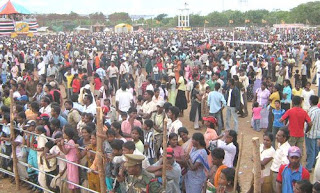by Stephen Long, Los Angeles
Yesterday’s heartless bomb blast aboard a public bus carrying students near University of Moratuwa in Sri Lanka that killed 21 and injured over 61 civilians reminded me of that Rolling Stones anthem of the early 70’s: “Sympathy for the Devil.”
I’m a man of wealth and taste.
I’ve been around for a long, long years
Stole many a man’s soul and faith.
And I was ‘round when Jesus Christ
Had his moment of doubt and pain
Made damn sure that Pilate
Washed his hands and sealed his fate.
I rode a tank
Held a general’s rank
When the blitzkrieg raged
And the bodies stank.
I watched with glee
While your kings and queens
Fought for ten decades
For the gods they made.
Pleased to meet you
Hope you guessed my name, oh yeah
And what’s puzzling you
Is the nature of my game, oh yeah
Thank you, Mick Jagger and Keith Richards for those timeless and insightful lyrics about the consummate evil megalomaniac. Have you guessed who these lyrics refer to these days? Of course: the devil himself, Mr. V. Prabhakaran, the leader of those merry cadres up north in Sri Lanka who’s “Stole many a man’s soul and faith.” Prabhakaran, the man who “washes his hands and seals the fate” of the innocent lives he destroys on a whim. The same man, Prabhakaran, who seems willing to “fight for ten decades,” and hold the “general’s rank” while “the bodies stank” in the streets of Colombo. We know “the nature of your game,” Prabhakaran; we’re not puzzled at all.
What really gets me is how could there possibly be anyone alive on the planet that would still have sympathy for a notorious devil like Prabhakaran, leader of the LTTE murder cult. After that senseless wasting of human lives in Moratua, what did it gain him? What was the purpose, other than to demonstrate his twisted will? Doesn’t everyone see that his perverted ego is the motivating force behind the killings; his ego and the delusional vision he has of himself at the helm of an independent Tamil state in Sri Lanka? How can anyone still support him and his cause after yet this latest senseless act of cold-blooded murder?
And yet, there are many around the world who DO support Prabhakaran and the LTTE. Why? Their media machine is strong, and their public relations mechanisms have loud, resounding, powerful voices. They have managed to convince many groups of people in influential positions, in important international organizations, that they are underdog freedom fighters – deserving of the public’s sympathy. Their media and lobbying efforts have seemingly won over honorable men like Jimmy Carter and Desmond Tutu. They’ve even managed to pull the wool over the eyes of the United Nations.
They have many weapons in their arsenal in addition to those hideous Claymore bombs. Their media and public relations weapons are the ones they are using most skillfully. They’ve even hired a mercenary of former high repute to be captain of their campaign: Bruce Fein, a former US Deputy Attorney General; he’s now their highly-paid ($100,000 a month) mouthpiece in Washington D.C. Last year LTTE operatives were even caught trying to bribe US State Department Officials. What’s next? They’ll do anything to promote their “image” as the downtrodden, stepped-on, discriminated-against people of Sri Lanka. But is killing countless numbers of innocent people (don’t forget, he kills innocent Tamils, too) really the warranted punishment for ancient sins that should have been resolved and forgotten centuries ago?
Wake up, people. Whatever ills may have been committed against Sri Lankan Tamils in the past are nothing compared to the murder of innocent students and pregnant women – whose unborn babies will never see the light of day.
Don’t be fooled by the Devil – and don’t have sympathy for him either!
Get real! Sympathy for Prabhakaran is nothing more than blatant ignorance. It’s time this demented ogre was permanently retired – and I’m looking forward to the day when they don’t give him a gold watch, but a prison cell as his reward.














